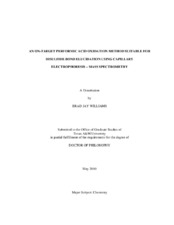| dc.description.abstract | Disulfide bonds play important roles in establishing and stabilizing three-dimensional
protein structure, and mass spectrometry (MS) has become the primary
detection method to decipher their biological and pathological roles. Several
experimental methods before or after MS detection have been developed to aid in
disulfide bond assignment, such as tandem MS followed by database searching or
modification of the disulfide bond via chemical reduction or oxidation. Despite these
technological advancements, the detection and proper assignment of disulfide bonds
have remained experimentally difficult. Therefore, we have developed an alternative
method for disulfide bond elucidation using capillary electrophoresis-mass
spectrometry (CE-MS) combined with an on-target performic acid oxidation method for
matrix assisted laser desorption/ionization (MALDI) deposited samples.
An information rich CE-MS method that results in distinct charge-state trends
observed in two-dimensional plots of log(mu eff) versus log (MW) was developed to
enhance the confidence of peptide and protein identifications. The charge-state trends
provide information about the number of basic amino acid residues present within each peptide. This information can be used to develop methods to screen for posttranslationally
modified peptides (e.g., phosphorylation, disulfide bonds, etc.). In the
case of disulfide bonds, the highly charged peptides (i.e., 3, 4 or greater charge states)
have a high probability of being disulfide-linked peptides, owing to charge contribution
of both peptides forming the disulfide bridged peptide. However, intra-linked disulfide
bridged peptides can also be present at lower charge states. Therefore, a chemically
selective method to rapidly locate disulfide-linked peptides that have been separated by
CE-MS must be developed.
An on-target performic acid oxidation method was developed to provide the
chemical selectivity towards disulfide bonds, i.e., converting the cystine bond to form
two peptides modified with a cysteic acid (SO3H) side chain. The on-target oxidation
method offers (i) no post-oxidation sample cleanup, (ii) improved throughput over
solution-phase oxidation methods, and (iii) easily adapted to CE separations coupled offline
with MALDI-MS. The evaluation of the on-target oxidation experimental
parameters, the fragmentation behavior of cysteic acid-containing peptides and an
alternative method for disulfide bond elucidation, using CE-MS combined with the ontarget
oxidation method, are discussed within. | en |


